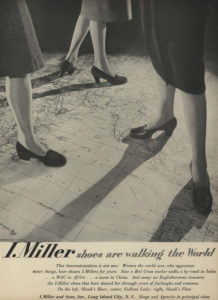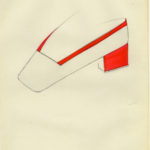
On January 12, 1945, the Grand Ballroom of the luxurious Waldorf-Astoria hotel in New York City was packed full as a thousand pair of curious eyes looked on as shoe industry executive George Miller and Lieut. Col. Harold L. Lister of the US Army posed awkwardly for a photo op. The snapshot was forever immortalized in the pages of Women’s Wear Daily the following day and ran with a press slug noting the occasion marked the presentation of the Army-Navy “E” Flag to Miller’s shoe company, I. Miller & Sons, for their esteemed wartime service.
The story of how I. Miller, a leading American manufacturer of footwear, came to receive official honors from the Armed Forces dates back three years earlier when in addition to its contiguous production of shoes, the company concurrently launched a Parachute Division. While the socialites, career girls and housewives back home clamored to slip on a pair of I. Miller’s high-end soles, the boys at the front outfitted themselves in I. Miller offerings as well: bulletproof vests, flying suits, gloves, leather helmets, electric boots and parachutes.
Research for this blog post first began several months ago during the initial phases of the COVID-19 pandemic. Sequestered, working remotely from home on a barely functioning laptop on a cold rainy afternoon, I assembled a healthy folder of primary sources on I. Miller & Company’s early history. It was not until returning to the project some months later that I uncovered a curious connection to recent events; how both then and now the American fashion industry pivoted their labor forces on a dime and came to public service in a moment of crises.
I will not belabor the predicament healthcare workers around the world faced in obtaining adequate personal protection equipment in the first weeks and days of the 2019/2020 pandemic. The virus being spread by respiratory droplets, medical workers needed medical grade N95 face masks to protect themselves from infected patients, but the nationwide supply of N95 masks—which were usually used once and then disposed of—was far from adequate. Healthcare workers were forced to resort to makeshift substitutions with far less efficacy; any face covering was better than no protection at all. Private individuals and fashion brands alike were quick to devote their sewing machines to churning out masks fashioned from whatever materials on they had on hand. These masks, in turn, were donated to the frontline workers so desperately in need.
More than 75 years ago, the American fashion industry also answered the nation’s call to act in a moment of crises. I. Miller & Sons joined the ranks of other fashion brands who converted their productions facilities to support the war effort. American Silk Mills made parachutes for both the Army and Navy. Norwich Knitting Co. produced underwear for the Armed Forces. The preeminent luxury textile manufacturer, Cheney Bros. diverted so much of their work force to war work, the brand’s fashion offerings were a coveted scarcity. Perhaps the most unusual wartime conversion was Chipman Knitting, the self-professed “first women’s hosiery mill” in the US, which remodeled their facilities to manufacture artillery shells and landmines.
Following the war, the majority the dozens of fashion brands that manufactured in the service of the country during WWII resumed business as normal, operating strictly in the realm of fashion. I. Miller & Sons’ reputation as one of America’s finest footwear brands grew throughout the 1950s and 1960s. FIT Special Collections and College Archives holds a selection of both original sketches and shoe samples of I. Miller models designed by noted footwear designer Arsho Baghsarian, and examples of I. Miller shoes can be found in many museum fashion and textile collections across the US.




